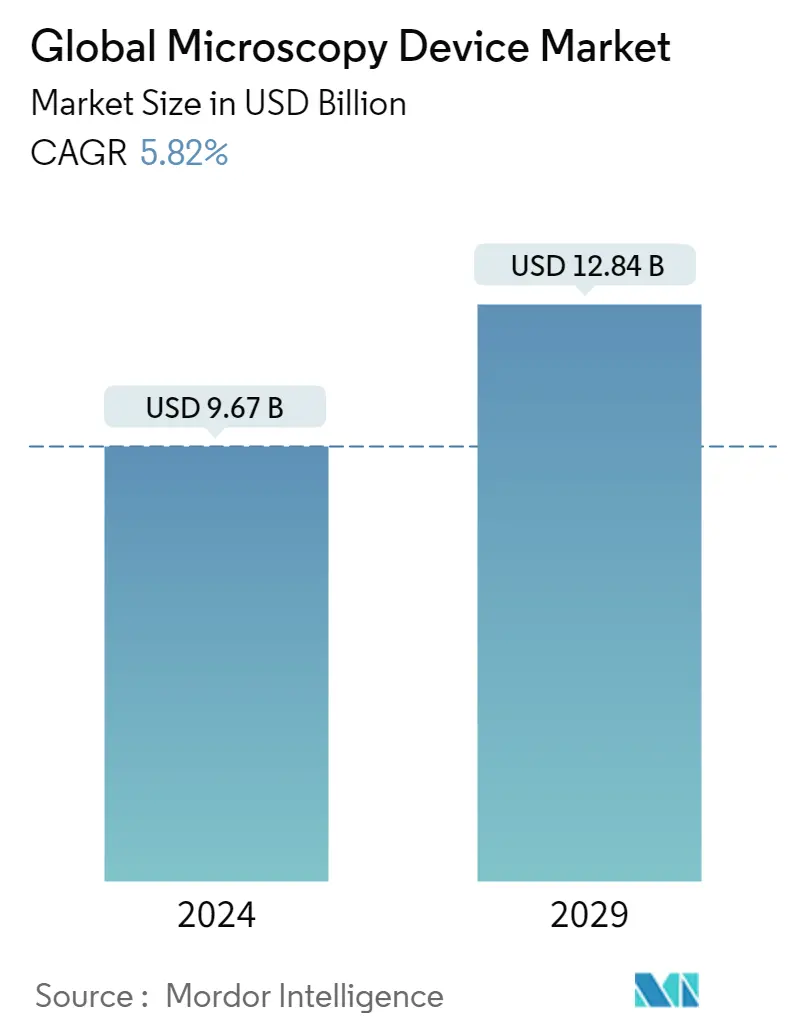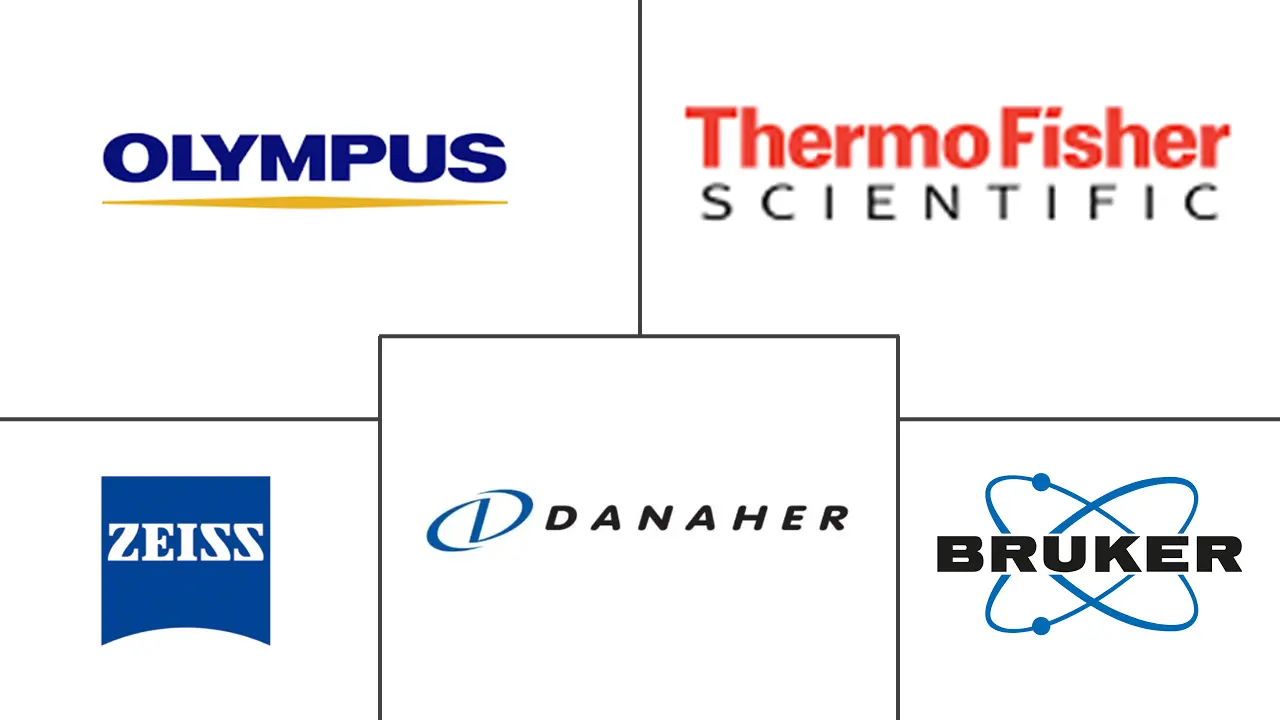Market Size of Global Microscopy Device Industry

| Study Period | 2019 - 2029 |
| Market Size (2024) | USD 9.67 Billion |
| Market Size (2029) | USD 12.84 Billion |
| CAGR (2024 - 2029) | 5.82 % |
| Fastest Growing Market | Asia-Pacific |
| Largest Market | North America |
Major Players
*Disclaimer: Major Players sorted in no particular order |
Microscopy Devices Market Analysis
The Global Microscopy Device Market size is estimated at USD 9.67 billion in 2024, and is expected to reach USD 12.84 billion by 2029, growing at a CAGR of 5.82% during the forecast period (2024-2029).
The microscopy devices are mainly used in the research and development activities in different industrial areas such as pharmaceuticals, electronics, life sciences, and others, and as there was lockdown or lockdown like restrictions around the world due to the COVID-19 pandemic, these activities were negatively impacted, and thus impacting the microscopy devices market around the world shortly. Although, the electron and other microscopes were very crucial in the structural analysis of the SARS-COV-2 virus which was very important in the development of diagnostics tests and vaccines against COVID-19. For example, according to the research article published in September 2020 in the 'Nature' journal, the researchers used high-resolution scanning electron microscopy for the ultrastructural analysis of the SARS-CoV-2 virus' interaction with the host cell. Also, due to COVID-19, the manufacturing, sales, and installment of the new microscopy devices were negatively impacted but with the increasing vaccination and decreasing infection cases, the market is expected to recover soon from the impact of COVID-19.
The technological advancements in the field of microscopy and improvements in the available devices are one of the major driving growth factors for the studied market along with the increasing research and development activities and investments in the area of nanotechnology and life sciences, globally. For instance, in December 2021, researchers from École Polytechnique fédérale de Lausanne (EPFL), Max Planck Institute for Biophysical Chemistry, and the University of Göttingen, developed a transmission electron microscope (TEM) with an advanced technique that enables a strong modulation of the electron beam, with only a few milli-Watts from a continuous wave laser. The approach constitutes a more simplification and efficiency increase in the optical control of electron beams, which can be seamlessly implemented in a regular transmission electron microscope and could make the scheme much more widely applicable. In the life science segment, the use of microscopy devices in the identification and diagnosis of microorganisms and viruses causing disease in humans, animals, or plants are increasing which will complement the growth of the market.
Furthermore, rising investments in the field of microscopy will further support new innovations which will b a key driving factor during the study period. For instance, in November 2021, Surrey won GBP 0.6 million Core Equipment Award from the Engineering and Physical Sciences Research Council (EPSRC) to develop a transmission electron microscope that allows users to see materials in three dimensions and to employ a host of other imaging techniques and fast chemical analysis, enabling new insights into the mechanisms and processes that happen within materials.
A wide variety of technologies associated with microscopes has opened up multiple lines of investigations. Electron cryo-microscopy has the ability toreveal the atomic structure of biomolecules such as proteins In addition Fluorescence microscopy has helped biologists to observe live samples in real-time. Moreover, an increasing number of inventions has also led to several advances such as the visualization of a broad range of morphologic features.
Also, the companies which offers microscopy devices are actively involved in the research and development of new innovative solutions for the studied market to have an edge over other competitors which will boost the growth of the microscopy devices market during the forecast period. For instance, in November 2021, JEOL Ltd. launhced a new scanning electron microscope (SEM), the JSM-IT510 series which allows the user to simply select the acquisition conditions and field of view for the SEM image, and then the SEM image is automatically acquired, thus making routine work more efficient. The Low-vacuum Hybrid Secondary Electron Detector (LHSED) in this microscope collects both electron and photon signals providing an image with high S/N and enhanced topographic information even under a low vacuum.
Other factors which will be the contributing factor for the growth of the microscopy device market are its demand in the electronics industry in the development of the semiconductor chips, in the material science and others. However, high cost associated with the advanced microscopy devices will impede the growth of the microscopy device market during the forecast period.
Microscopy Devices Industry Segmentation
As per the scope of the report, the microscopy devices are one of the most important devices in any laboratory that are used in the structural analysis of any biological or non-biological object or material at the micro or nano level which cannot be performed through the naked eye. The microscopy devices are used widely across the life sciences domain as well as material science and information technology. The microscopy device market is segmented by type (electron microscopy, optical microscopy, scanning probe microscopy, and others), application (nanotechnology, life science, semiconductor, material science, and others), end-user (hospitals, clinics and diagnostics laboratories, academic and research organization, and others), and geography (North America, Europe, Asia-Pacific, Middle East and Africa, and South America). The market report also covers the estimated market sizes and trends for 17 countries across major regions globally. The report offers the value (in USD million) for the above segments.
| By Type | |
| Electron Microscopy | |
| Optical Microscopy | |
| Scanning Probe Microscopy | |
| Others |
| By Application | |
| Nanotechnology | |
| Life Science | |
| Semiconductor | |
| Material Science | |
| Others |
| By End User | |
| Hospitals, Clinics and Diagnostic Laboratories | |
| Academic and Research Organizations | |
| Others |
| Geography | ||||||||
| ||||||||
| ||||||||
| ||||||||
| ||||||||
|
Global Microscopy Device Market Size Summary
The microscopy devices market is poised for significant growth, driven by advancements in technology and increasing research activities across various sectors such as pharmaceuticals, electronics, and life sciences. The market experienced temporary setbacks due to the COVID-19 pandemic, which disrupted manufacturing and sales activities. However, the critical role of microscopy in understanding the SARS-CoV-2 virus and the subsequent recovery in research activities have set the stage for a robust market rebound. Technological innovations, such as the development of advanced transmission electron microscopes and electron cryo-microscopy, are enhancing the capabilities of these devices, making them indispensable in fields like nanotechnology and disease diagnosis. The market is further bolstered by strategic investments and partnerships, which are fostering new product developments and expanding the application scope of microscopy devices.
North America, particularly the United States, holds a significant share of the microscopy devices market, supported by substantial investments in research and development. The region's market growth is attributed to the rising prevalence of chronic diseases, technological advancements, and the introduction of innovative products. Strategic partnerships, such as those between ZEISS Microscopy and LabCentral, are enhancing access to advanced microscopy solutions, thereby driving market expansion. The presence of major global players like Thermo Fisher Scientific, Carl Zeiss, and Olympus Corporation, along with emerging companies offering innovative solutions, is expected to sustain the market's growth trajectory. As the demand for high-resolution imaging and advanced analytical capabilities continues to rise, the microscopy devices market is set to experience robust growth in the coming years.
Global Microscopy Device Market Size - Table of Contents
-
1. MARKET DYNAMICS
-
1.1 Market Overview
-
1.2 Market Drivers
-
1.2.1 Technological Advancements in the Field of Microscopy
-
1.2.2 Increasing Demand for Focus on Nanotechnology and Life Science Research
-
-
1.3 Market Restraints
-
1.3.1 High Cost of Advanced Microscopy Devices
-
-
1.4 Porter's Five Force Analysis
-
1.4.1 Threat of New Entrants
-
1.4.2 Bargaining Power of Buyers/Consumers
-
1.4.3 Bargaining Power of Suppliers
-
1.4.4 Threat of Substitute Products
-
1.4.5 Intensity of Competitive Rivalry
-
-
-
2. MARKET SEGMENTATION (Market Size by Value - in USD Million)
-
2.1 By Type
-
2.1.1 Electron Microscopy
-
2.1.2 Optical Microscopy
-
2.1.3 Scanning Probe Microscopy
-
2.1.4 Others
-
-
2.2 By Application
-
2.2.1 Nanotechnology
-
2.2.2 Life Science
-
2.2.3 Semiconductor
-
2.2.4 Material Science
-
2.2.5 Others
-
-
2.3 By End User
-
2.3.1 Hospitals, Clinics and Diagnostic Laboratories
-
2.3.2 Academic and Research Organizations
-
2.3.3 Others
-
-
2.4 Geography
-
2.4.1 North America
-
2.4.1.1 United States
-
2.4.1.2 Canada
-
2.4.1.3 Mexico
-
-
2.4.2 Europe
-
2.4.2.1 Germany
-
2.4.2.2 United Kingdom
-
2.4.2.3 France
-
2.4.2.4 Italy
-
2.4.2.5 Spain
-
2.4.2.6 Rest of Europe
-
-
2.4.3 Asia-Pacific
-
2.4.3.1 China
-
2.4.3.2 Japan
-
2.4.3.3 India
-
2.4.3.4 Australia
-
2.4.3.5 South Korea
-
2.4.3.6 Rest of Asia-Pacific
-
-
2.4.4 Middle East and Africa
-
2.4.4.1 GCC
-
2.4.4.2 South Africa
-
2.4.4.3 Rest of Middle East and Africa
-
-
2.4.5 South America
-
2.4.5.1 Brazil
-
2.4.5.2 Argentina
-
2.4.5.3 Rest of South America
-
-
-
Global Microscopy Device Market Size FAQs
How big is the Global Microscopy Device Market?
The Global Microscopy Device Market size is expected to reach USD 9.67 billion in 2024 and grow at a CAGR of 5.82% to reach USD 12.84 billion by 2029.
What is the current Global Microscopy Device Market size?
In 2024, the Global Microscopy Device Market size is expected to reach USD 9.67 billion.

